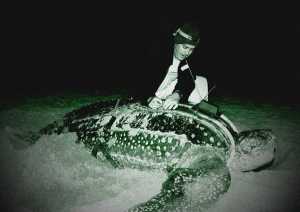Grant: 04-006R
Project Title: Characterizing the FL Leatherback Population
Project Manager: Chris Johnson
Organization: Loggerhead Marinelife Center (Non-Profit Organization)
Grant Amount: $15,739.50
Completion Date: 2006-07-06
Summary: For the past three years, the Marinelife Center has led an immensely successful leatherback tagging program on the beaches of Northern Palm Beach County, identifying 116 individual females. This project will continue this effort, and for 2004 season, add satellite telemetry studies to delineate internesting habitat and physiological studies to examine environmental stresses on nesting females. There has been a significant increase in the number of leatherback sea turtle nests over the past decade in Florida. This increase could represent the rapid colonization of Florida beaches, this phenomenon has been observed for other Caribbean beaches. It is critical to collect baseline population information for this important nesting aggregation with the goal of contributing data to an effective management plan.  Results: The survey area (Jupiter Inlet to Lake Worth Inlet = 20 km = 12 miles) was patrolled every night from 9 pm to 6 am from March 5th to June 17th. Total leatherback observations was 73, representing 34 individuals, 20 of which had no tags when we encountered them. Genetic samples were collected and will be sent off for processing by the end of the year. We hope to be able to determine how closely related our female leatherbacks are to others in the Caribbean. We also collected blood samples for contaminant analysis (PCBs etc). We have documented many injuries on our turtles this year. Fourteen of our 34 females had healed or fresh injuries which may have come from interactions with fisheries or boats. One of our turtles, “Sedna”, has a large hook embedded in her shoulder muscle; we could only detect this using a metal detector. Usually leatherbacks nest every 2 years, and some take longer than that before they return. However we had 3 turtles return this year that we tagged just last season. For some reason, it took them only one year to be ready to nest again. Several of our observations were of tagged turtles from 2002. On May 21st, we fitted one leatherback with a satellite transmitter. Her results have already proved interesting. We are now beginning to analyze the data and we are currently preparing a paper for publication on the movements of this turtle and others tracked from the coast of Florida. (Author: Chris Johnson)
Results: The survey area (Jupiter Inlet to Lake Worth Inlet = 20 km = 12 miles) was patrolled every night from 9 pm to 6 am from March 5th to June 17th. Total leatherback observations was 73, representing 34 individuals, 20 of which had no tags when we encountered them. Genetic samples were collected and will be sent off for processing by the end of the year. We hope to be able to determine how closely related our female leatherbacks are to others in the Caribbean. We also collected blood samples for contaminant analysis (PCBs etc). We have documented many injuries on our turtles this year. Fourteen of our 34 females had healed or fresh injuries which may have come from interactions with fisheries or boats. One of our turtles, “Sedna”, has a large hook embedded in her shoulder muscle; we could only detect this using a metal detector. Usually leatherbacks nest every 2 years, and some take longer than that before they return. However we had 3 turtles return this year that we tagged just last season. For some reason, it took them only one year to be ready to nest again. Several of our observations were of tagged turtles from 2002. On May 21st, we fitted one leatherback with a satellite transmitter. Her results have already proved interesting. We are now beginning to analyze the data and we are currently preparing a paper for publication on the movements of this turtle and others tracked from the coast of Florida. (Author: Chris Johnson)